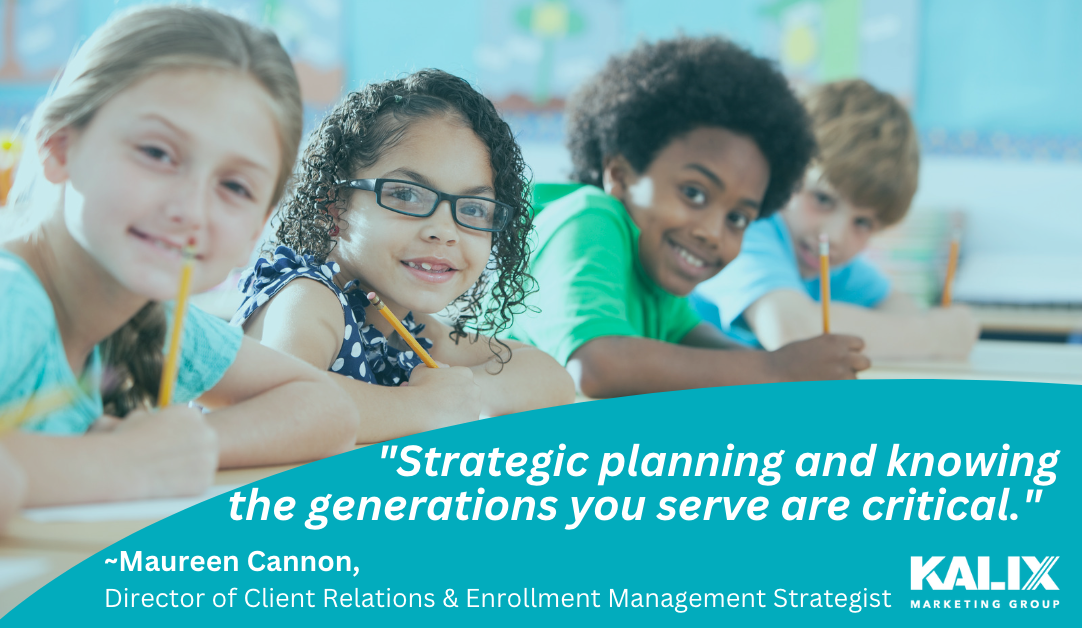This month, Maureen Cannon, independent school enrollment management veteran, joined the Kalix team. She brings three decades of experience and expertise in enrollment management to Kalix’s comprehensive, customized strategic marketing focus for the educational community.
We talked with Maureen about enrollment marketing trends, what she sees as essential for schools and about what parents truly want from independent schools.
Q: Why is strategic marketing essential to enrollment and retention?
MC: Strategic marketing is incredibly essential to enrollment, retention and admissions because you have to have a plan in place in order to serve your prospective and current families. Strategic marketing is about assessing the landscape. What does your admissions landscape look like? What do your competitors look like? What are the differentiating factors for your school that’s going to set you apart? Then build messaging around those essential factors.
You need to know what separates your school from your competition. That’s the driving factor. It’s what parents want parents want to know. They want to find out what your school does that will benefit their child and their family and what will be the return on their investment. That’s why strategic planning and knowing the generations you serve are critical. You need to understand what the different generations of parents want and how to strategize to market to and recruit them.
Parents want a lot these days. What does your school offer that’s going to give them what they want? That has to be top of mind during the recruitment process. You can never lose sight of that. Oftentimes people in the admissions world get caught up in the day-to-day: getting school visitors in, doing events. But we have to pause long enough to always remember the audience and to drive our message to what they seek for their child
Q: How important is market research to strategic planning?
MC: During my 16-year enrollment management career at Notre Dame Preparatory School [see her full bio below], we did a market research study. Market research has to be foundational to strategic marketing and planning–100% percent. The research will determine what your prospects think of your school and your reputation and will identify your school’s strengths and weaknesses. Is a weakness point a tuition gap between you and a competitor? Is it a perception challenge? Or, is it something else of which you were unaware? Market research provides critical insight and allows for intentional planning– short-term and long-term.
At NDP, we used market research to help figure out where we were in the Baltimore landscape with our price point and with perceptions in the marketplace. It helped with strategic planning for marketing advertisement and our communication strategy.
Market research also helps at the academic level because the market research also helps you see what your competitor schools look like and what you need to do, maybe, to build on academic programming. So, it’s really an all-school benefit.
Download Kalix’s free e-book, Market Research: What It Is And Why It Matters.
Q: Let’s talk retention, which for many schools is an afterthought with enrollment management programming. What are your thoughts on the importance of retention programs and messaging?
MC: You absolutely need to think about the retention piece. It’s not just getting the students/families in the door, it’s keeping them behind the desks. Retention is the foundation for the school’s budget. From a very practical standpoint, you’ve got to retain your current families for the school to be fiscally sound. Retention has become so critically important since Covid. Current families came to your school for a reason. You need them to stay for those reasons and more. If you don’t have strong retention, you’re going to have a harder time marketing your school.
How do you focus on retention? Simple – harnessing relationships with key school stakeholders. I valued the collaboration I built with guidance counselors, faculty, coaches and parent ambassadors. These partners are the eyes and ears of hearing from current students/families who may experience struggles, social concerns, academic challenges or other factors that put retention at risk. By keeping communication lines open with these school stakeholders, my admissions department was better prepared to address attrition factors and implement a retention program. And, in my prior role, we had a consistently low annual attrition rate between 1.5-2.5% – much lower than the region and national averages.
Q: What admissions and enrollment trends, especially post-Covid, are on your radar?
MC: Pre-Covid, title changes began to reflect the alignment for recruitment and retention. I went from being the director of admissions to the director of enrollment management. This was pretty universal across the Baltimore independent school landscape and nationally. Post-Covid, the big trend actually is dual-income families who are willing to pay for an independent school education. Even in a questionable economy, my experience is that higher-income families are deciding to commit to an independent, private religious school education. [NDP is a Catholic girls school.] Families are looking for the value add.
Pre-Covid, families were making decisions on reputation. While it is still about the reputation of a school, there’s a lot of school shopping, but tuition sticker price isn’t necessarily scaring away families. That’s a trend I did not expect, but it’s sustained. I saw an earlier stat this spring from NAIS that referenced independent school enrollment in the Baltimore area will increase almost 3% over the next five years. Families are willing to pay for a values-based rigorous education for their children. (We’ll save the importance of financial aid and essential need for income diversity for another Kalix blog post.)
Another trend most enrollment management offices are seeing is the demand for personalization. Families want personal touches, one-on-one time and want to ensure that if they are considering making the investment in their child (children), the school will invest its time in getting to know them. There is a much higher level of personalization needed to take a prospective student through the funnel these days. From the first impression at an event like an open house to individual conversations with parents, to providing interest-specific student engagement opportunities for prospective students, there is a heightened demand for personalizing the admissions process.
Q: What are some of the demographic trends that are impacting independent school education now and in the next several years?
MC: Demographic trends must be a big part of a school’s enrollment management strategic planning. People look to reduce expenses and birth rates drop when we go into a recession and have national and global economic challenges. That is exactly what happened after the recession of 2007-2008. The number of children born went down because families had fewer children. The two-, three- and four-kid families shrunk. This demographic is called the Recession Babies. In my experience, the Recession Babies hit middle school three years ago and began to impact high school grade levels as early as this school year (2022-2023). For elementary schools, the Recession Babies hit much earlier; schools may have noticed that. It’s noticeable that the kids aren’t there. Schools need to be aware of and plan for these demographic trends so they can be smart with budget and programming needs.
That’s why demographic data is equally as important to a school’s strategic planning and recruitment marketing because the data lets schools know what’s coming down the enrollment and recruitment pipeline. You must think three to five years ahead, depending upon the city and region where you operate your school, because economic issues impact areas differently.
Q: Do you have any go-to tools for enrollment management?
MC: Use every demographic profile tool and resource that you can. There are lots of great tools to assess what the landscape looks like. NAIS has a great demographics resource library where you put in your school’s zip code to see school-aged kids all around you, household incomes, percentage of school-aged kids whose families can afford the tuition and the percentage that might need financial aid. You can use Census data or your state’s demographic data or other outlets. If your school has a healthy budget for admissions marketing resources and tools, one of the best databases I ever used was Datastory. I firmly believe that schools should budget for robust market dollars; it is imperative to recruitment and enrollment success, especially when there is a demographic shift.
Q: Why did you get into this work and what do you find rewarding about it?
MC: I absolutely love enrollment management. You don’t go to college to major in it. It’s a vocation that finds you. I love that it’s mission focused. You’re working in an education environment that you believe in and helping families give their child/children that opportunity. I’m all about opportunities. Independent and private schools do that for kids better than any other school choice out there.
Also, I’m a people person. I love talking to people. We encounter so many different personalities in enrollment management. It’s not always an easy job, but you get to learn a lot about everyone else, and you’re not in a silo. You get to advocate for students/families and share their successes/challenges and support them. I love watching students enter the school and experience all it can offer them– thriving, learning, growing– and encourage the students to take advantage of the resources the school can offer them.
Relationships, opportunities and being mission-centric are what drove me to this field. As a parent of kids who went through Catholic independent schools, I’ve seen the return on the investment. Watching my kids go to college and continue to thrive absolutely reinforces my family’s decision to send them to private school. I was known to tell prospective parents that ‘not everyday is sunshine and roses.’ But, I wouldn’t have wanted to have my daughters anywhere else, especially on their more challenging days. For me, the gift of an independent, Catholic school education will be among the best gifts/opportunities I could give them. .
Q: What is your new role at Kalix?
MC: I partner with my Kalix team members to coordinate client relations and help clients strategize when they’re working with other Kalix experts. I am Kalix’s enrollment management and admissions expert. I want to be able to help schools help themselves. If there is an admissions office that needs help with strategic planning, help understanding the admission funnel work, putting a recruitment and marketing plan together, evaluating their processes and efficiencies, I want to work with them. I really love helping other schools market themselves to raise their school’s visibility. Because it really starts there. Schools need to market themselves, but they’ve got to market themselves effectively to get the families in the door – and keep them at the school–for sustainability. Admissions/recruitment go together.
Q: What’s the one thing you would want enrollment management professionals working in independent schools to know?
MC: Intentionality. You have to be intentional with every part of this job. You can’t just make decisions arbitrarily. What I mean by ‘being intentional’ is when you’re making a decision to do a social media campaign, be intentional with the messaging. Be intentional with events and make sure that they are going to be planned to yield the results your school seeks. Intentionality brings assessments; it is equally as important to survey, debrief and analyze. Every aspect of admissions is different, but you have to be intentional with every single thing you are doing. Enrollment management offices juggle so many tasks and challenges on a daily basis. Learning to manage the day to day while also carving out time to be planful can and should exist within the admissions office. Great intentionality leads to success.
ABOUT MAUREEN CANNON
Director of Client Relations and Enrollment Management Strategist

With a passion for education and supporting mission-driven organizations, Maureen Cannon brings 27 years of leadership and enrollment management expertise to Kalix Marketing Group. She spent 16 years in admissions, recruitment and enrollment management in the independent school marketplace at Notre Dame Preparatory School (NDP) in Baltimore. Promoted three times during her NDP tenure, the last 11 years she was the director of admissions and enrollment management, recording NDP’s highest enrollment in five of those 11 years. Additionally, she was a NDP parent for seven years as both her daughters are graduates.
Prior to NDP, Maureen spent seven years at the nonprofit Baltimore Collegetown Network, a marketing arm for the 14 Baltimore-area colleges and universities. She has vast experience in advertising, marketing, fundraising, client-relations and project management for other education and nonprofits. As a recruitment/enrollment management and education marketing expert, Maureen enjoys sharing her knowledge and expertise with Kalix clients.


